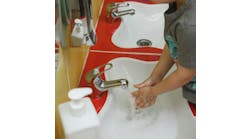For decades, students approached the typical school shower with dread. Many people can recall trying to skip the showers only to be handed a towel and told to get in line — no exceptions.
Today, mandatory showers are mostly a thing of the past because of budget cuts and potential harassment lawsuits. Many students rarely, if ever, use showers in locker rooms. This has caused some schools to remove shower areas to make space for additional storage. Still, many new schools are required to install showers to meet building codes.
Some schools have a need for showers beyond students and their sports teams. Recreation facilities at many schools often are available for community use. Those users, as well as many students, can benefit from clean and well-designed locker facilities.
Upgrading school locker rooms can encourage more students to use showers. A school's goal should be to improve student hygiene by providing convenient and user-friendly facilities. Just as many professional sports teams have renovated their locker rooms to improve player morale and attract top talent, a school can upgrade its locker rooms to improve students' attitudes.
Privacy, please
Privacy remains a primary concern for students and must be taken into account. Many kids have their own bedrooms and even bathrooms, so public washrooms and locker rooms need to offer some level of privacy. There is no standard way to tackle the privacy challenge, and for most schools, the available budget determines the scope of the solution.
On the higher end, individual showers with adjacent changing areas are common, such as in private high schools and universities. Although this level of privacy costs more, it may not be the expense that deters schools from going this route. Security is a concern, and most schools prefer to monitor students more closely.
A more common privacy option for middle and high school shower rooms is to use column showers or wall showers and partitions. Similar to toilet partitions, these “modesty modules” are short partitions built around a prefabricated shower fixture. These units give schools the flexibility to use vandal-resistant group shower fixtures, while offering users some privacy. The modules can be combined to create clusters of space-saving shower stations.
To ensure that showers are not left running, schools can install pushbutton metering valves. Electronic metering valves are reliable and can be set with a longer running time so that students are encouraged to shower completely, and are not frustrated by the water stopping after 15 seconds.
Installing pressure-balancing or thermostatic-mixing valves at each shower gives users control over the water temperature. These valves provide scald protection and thermoshock protection, and can withstand frequent use. Finally, choosing showerheads with a larger, more comfortable spray pattern can provide a more pleasant shower experience.
Amenities aplenty
Often students are not assigned permanent lockers, so bringing soap and other supplies can be another obstacle to showering. Installing soap and shampoo dispensers in each shower is an easy remedy. Large towels also should be provided, if possible.
Other features, particularly in girls' locker rooms, can reduce the hassle of getting ready for class after a shower. Vanity areas with a large mirror and countertop should be allotted to give users plenty of space to dry their hair or apply makeup. Built-in dryers mean one less appliance for students to bring with them. This type of layout has another key benefit. Removing mirrors from above the sinks in the restroom decreases congestion near handwashing stations.
Sinks and lavatory fixtures do not need to be white and institutional-looking. Solid-surface lavatory systems are durable, yet they create a custom look. These lavatories can be specified in a range of colors from neutrals with the look of granite to deeper shades that contrast or coordinate with the overall locker room design. Either way, these fixtures can be paired with matching toilet partitions and other accessories.
Lighten up
A critical and often overlooked design element is lighting. Locker rooms often look and smell much like musty basements. Most new schools are finding ways to incorporate a dose of sunlight into their locker room plans. Bringing in natural light is a great way to create a more inviting space. An added benefit is fewer germs, as bacteria prefer dark, damp areas.
Adding windows may not be an option for older schools. However, many facilities could get a lift by improving existing lighting. Recessed lights are easy to install and generate softer lighting than the old fluorescent fixtures. Halogen track lights also can be used to spotlight a student-painted mural or an athletic announcement board.
One of the least expensive ways to brighten any room is with a little paint. Locker rooms do not need to be boring beige, or pink or blue. Convey an upscale look without the cost with a combination of earthy shades and rich accents of color. For rooms without natural light, create the illusion of brightness with bolder paint.
Don't forget to keep the floors in step with the rest of a new locker room. Better lighting and fresh paint will make dingy tiles look worse. Carpeting can enhance the look and feel of a room, reduce the risk of slipping and improve energy efficiency. In addition, carpeting with an antimicrobial treatment inhibits the growth of bacteria and works well in damp areas.
With better lighting, it is important to adopt a regular cleaning and maintenance schedule, as dirt and grunge will be easier to spot. Unsanitary showers are a turnoff, so be sure they look clean and smell fresh. It is important to select products and choose a locker room layout with maintenance in mind.
Lock it up
A material that is easy to maintain and ideal for wet locker rooms is plastic. Rusted metal lockers do not create an inviting atmosphere. Plastic lockers never need to be repainted and will not rust or delaminate. Maintenance staff can wipe away graffiti with everyday cleaners, and the lockers are available in a range of shades and can be customized.
An important consideration when selecting lockers is the total number needed and the different levels or tiers of lockers that can be combined to meet this need. The type of door is another feature to consider. Mesh locker doors are a popular choice for schools from a safety standpoint, and these open-concept doors also prevent odor buildup.
Coordinating accessories can maximize existing locker room space. Locker benches are one example. Plastic cubby lockers or locker baskets are effective for open storage areas or to organize sports equipment.
Bonney is the product manager for Lenox Lockers at Bradley Corporation, a manufacturer of locker room products, plumbing fixtures, washroom accessories, partitions and emergency fixtures.

